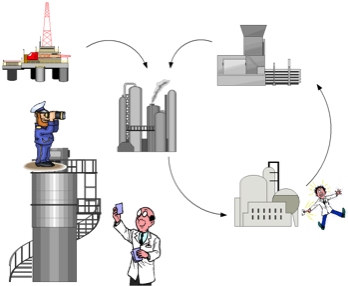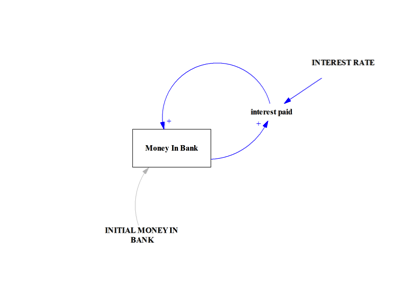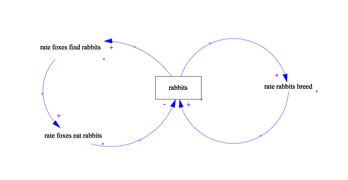System Dynamics
System Dynamics is the study of the behaviour of systems through the investigation of the effects of the dynamic responses of both the system itself and its linked control systems.
Many management systems are poorly designed to control the dynamical systems with which they interact. The human mind is not easily able to apprehend the effect of multiple interacting feedback loops and the resulting complex behaviour of the overall system.
There are many examples of these kind of problems:
Even global warming has links to these kinds of perception difficulties, we are basing our decision making now on the current state of the system, not the state of the system as it will be in the future. The more complex the system, the harder it is to see the effect of changes to the system without tools such as simulation.
Many management systems are poorly designed to control the dynamical systems with which they interact. The human mind is not easily able to apprehend the effect of multiple interacting feedback loops and the resulting complex behaviour of the overall system.
There are many examples of these kind of problems:
- A company spends money on marketing without increasing its sales force or its production capacity to deal with the resulting flow of orders.
- Long lag times in the response of the supply of a commodity such as housing stocks lead to wild swings in the price of the commodity as decisions are based upon the current state of the system rather than its anticipated future state.
- A company tries to bring a behind-schedule project back on track by recruiting lots of new staff, whose training and higher error rates only serve to make the project yet further behind schedule.
Even global warming has links to these kinds of perception difficulties, we are basing our decision making now on the current state of the system, not the state of the system as it will be in the future. The more complex the system, the harder it is to see the effect of changes to the system without tools such as simulation.

Feedback Loops
In System Dynamics a model is developed of the system showing the influences that operate in the system. These influences will be quantified as the model is developed but in the early stages the most relevant and the easiest to understand is the feedback structure of the model. Systems are inter-linked nests of feedback loops, whose connections give rise to the behaviour of the system.
Most systems are controlled by negative feedback loops of one kind or another. A classic thermostatic control on a radiator will close as the radiator warms, reducing the rate at which the radiator warms until almost no hot water is flowing through the valve. This kind of negative feedback produces a well-controlled system but if feedback is instead based upon something that is significantly delayed or not directly linked to the actual variable of interest all kinds of anomalous behaviour can be seen.
Much of this behaviour is analogous to the need to control feedback in electrical circuits, where circuits need to be designed so as to avoid undesirable feedback. Many management systems are poorly designed to control feedback effects and this is particularly true where there is no overall controller. Systems such as the economy can often oscillate out of their range of control due to systems of incentive that lead to too much positive feedback in the system and not enough negative feedback. This leads to the business cycle in benign cases and cycles of boom and bust in more challenging circumstances.
- Positive feedback loops are where a change up or down in a variable leads to an accelerating change in that variable. Thus compound interest is a classic form of positive feedback loop, the more money you have, the more interest you earn and the more money you have.
- Negative feedback loops by contrast are where a change up or down in a variable leads to a restoring change in the variable. Thus an increase in the number of rabbits leads to an increase in the number of foxes which leads to a decrease in the number of rabbits.
Most systems are controlled by negative feedback loops of one kind or another. A classic thermostatic control on a radiator will close as the radiator warms, reducing the rate at which the radiator warms until almost no hot water is flowing through the valve. This kind of negative feedback produces a well-controlled system but if feedback is instead based upon something that is significantly delayed or not directly linked to the actual variable of interest all kinds of anomalous behaviour can be seen.
Much of this behaviour is analogous to the need to control feedback in electrical circuits, where circuits need to be designed so as to avoid undesirable feedback. Many management systems are poorly designed to control feedback effects and this is particularly true where there is no overall controller. Systems such as the economy can often oscillate out of their range of control due to systems of incentive that lead to too much positive feedback in the system and not enough negative feedback. This leads to the business cycle in benign cases and cycles of boom and bust in more challenging circumstances.


Dynamic Modelling
Understanding the behaviour of complex systems of inter-linked feedback loops is something that is not easy. When links between cause and effect are straightforward and linear intuition serves as a good basis for decision making. When relationships are non-linear it can be useful to build models and simulations of systems so as to understand what is going on and the likely result of any intervention.
System Dynamics provides a set of tools to visualise complex systems and build qualitative and quantitative models of those systems that allow the behaviour to be explored.
System Dynamics provides a set of tools to visualise complex systems and build qualitative and quantitative models of those systems that allow the behaviour to be explored.
Sensitivity
System Dynamics models can explore the sensitivity of the system to changes in input parameters. Large numbers of runs can be carried out by systematically or randomly changing variables of interest to see which are the most sensitive part of the system. This allows the modeller and the decision-maker to see where most effort needs to go in terms of data collection and data assurance. Whilst it would be nice to ensure that all the data going into the model is absolutely accurate there is always a time taken to gather and review data. By using sensitivity analysis we can see where the most effort needs to be put in terms of gathering and reviewing data.
Sensitivity modelling can also show which variables under the control of the decision maker are likely to have the biggest impact on the system, for good or for bad. These are the most effective levers available for influencing the behaviour of the system and one of the characteristics of dynamic systems is that some of the most obvious levers can also be the most ineffective, since they may be connected up to various negative feedback loops which act to counteract the effect desired.
Sensitivity modelling can also show which variables under the control of the decision maker are likely to have the biggest impact on the system, for good or for bad. These are the most effective levers available for influencing the behaviour of the system and one of the characteristics of dynamic systems is that some of the most obvious levers can also be the most ineffective, since they may be connected up to various negative feedback loops which act to counteract the effect desired.
Optimisation
Similar tools can be used to optimise the system. The user specifies an objective function - something that represents what needs to be Improved. For many commercial organisations this can be profit and loss, but these kind of approaches can also be used where other outputs of the system need to be maximised or minimised. For example, in a model of a call centre the objective might be to maximise customer satisfaction subject to limits on maximum spend. The user then specifies a set of characteristics of the system that he or she has influence over. For a call-centre model one variable might be the pay on offer. Higher pay will reduce turnover of employees which will reduce the need for retraining and generate higher customer satisfaction. The model will then vary the chosen variables until it has maximised the chosen output function. This can be a very effective way to work out how to get the best from a complicated dynamic system where linear approaches to cause and effect often unnecessarily limit the options chosen to improve performance.